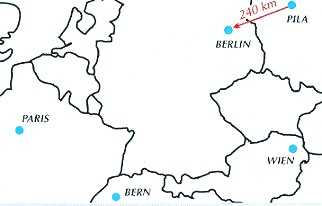
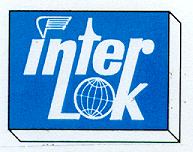
INTERLOK Ltd. WORLD STEAM CONGRESS
Warsztatowa 8 BRIENZ, 6.-8.10.2003
PL-64-920 Pila (POLAND)
email: office@interlok.info
email : interlok@wp.pl
Hermann Schmidtendorf, President of INTERLOK Supervision Board
"L.D.Porta's Coal and Timber Gazification System - Polish Experiences with Steam Locomotives in the 80ies and an Outlook onto the Future"
Our railway repair work shop is situated in Pila. 240 km from Berlin, in the North-West of Poland.


In 1905, we were founded as the then-Prussian Repair work shop Schneidemühl of German States’ railway Reichsbahn. So, within 2 years time, we will celebrate our 100th birthday. In 1945, our company was incorporated into the Polish States’ Railway PKP. In 1987 – during the communism – we founded INTERLOK as a German-Polish private-public joint venture that took over the steam locomotive department. In 1999, INTERLOK was fully privatized by share holders from Poland, France, Switzerland, Germany, and Greece. The affiliated diesel locomotive repair department also was privatized. INTERLOK works as a manufaction, and repair workshop, as well as a trade company for virtually all topics connected to railway.
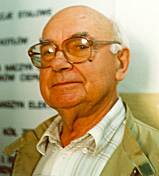
This is engineer Mr Henryk GODZISZ. Mr Godzisz is with us for all his life time – starting as a worker in the production, ending as the chairman of the whole company for many years in a time when we had about 3000 workers , undertaking heavy repair work to about 300 steam locomotives per month. I don’t need to say that his knowledge is very important to us.
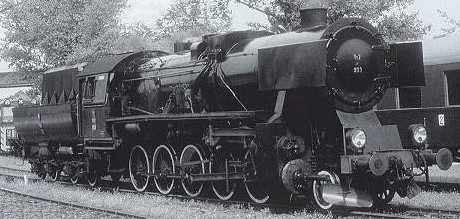 In 1984 and 1985, we modified and
modernized two steam locomotives of 2-10-0 German Kriegs
Lokomotive class 52 – Polish Ty 2 – according to Livio
Dante Porta’s GAS PRODUCER COMBUSTION SYSTEM (GPCS). On this
photograph, You see one of these locomotives – Ty 2 No 953.
PKP states’ Railway allowed us to realize these
modernizations as they were discussing to modify all existing 150
locomotives of that class to that system. Diesel and Electric
locomotives finally found more supporters at PKP, but at least,
we were able to demonstrate that the GPCS system is a good way to
improve existing locomotives without large financial investments.
The locomotives received, among others, a modified steam draught.
The modifications included:
In 1984 and 1985, we modified and
modernized two steam locomotives of 2-10-0 German Kriegs
Lokomotive class 52 – Polish Ty 2 – according to Livio
Dante Porta’s GAS PRODUCER COMBUSTION SYSTEM (GPCS). On this
photograph, You see one of these locomotives – Ty 2 No 953.
PKP states’ Railway allowed us to realize these
modernizations as they were discussing to modify all existing 150
locomotives of that class to that system. Diesel and Electric
locomotives finally found more supporters at PKP, but at least,
we were able to demonstrate that the GPCS system is a good way to
improve existing locomotives without large financial investments.
The locomotives received, among others, a modified steam draught.
The modifications included:
a) incorporation of a mechanical coal firing device (STOKER) (being taken from American steam locomotives that were running in Poland). A traditional coal combustion needs a coal bed of about 150 mm hight. For the GPCS system, You need an equal coal bed of about 400 mm. The stoker ensures a steady coal bed of that hight.
(CONCLUSION I: For future steam locomotives, this also is a possibility to change a steam locomotive to one-man-operation, eventually, if the local law should ask for it, in combination with video supervision of the fire man’s side of the locomotive).
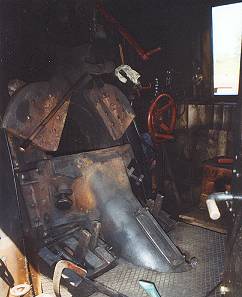
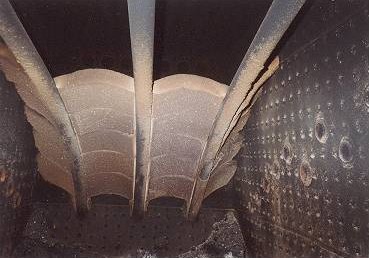
The fire screen was being enlarged by adding two rows of chamotte bricks, creating a kind of cumbustion chamber and prolonging the way for the cumbustion gases. It was important that the ash box was completely isolated against un-planned air flow. A concious secondary air additionally was given with the help of two air tubes that were blowing fresh cool air underneath the fire bars, cooling them and taking part in the combustion process. This air was taken from the three way valve.
At the top of the fire box, as well as on both sides of it, there were installed air nozzles that were connected at the outside with draught openings. These openings could be opened and closed by hand, changing by that way the diameter of the air nozzle channels.
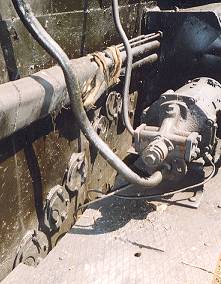 (CONCLUSION
II: FOR FUTURE STEAM LOCOMOTIVE MODERNIZATIONS, these openings
ought to be connected to a remote control from the driver’s
cabin (eventually in cooperation with air analyses from inside
the fire box).
(CONCLUSION
II: FOR FUTURE STEAM LOCOMOTIVE MODERNIZATIONS, these openings
ought to be connected to a remote control from the driver’s
cabin (eventually in cooperation with air analyses from inside
the fire box).
| On 110 km test ride: | Usage of coal | savings of coal |
| traditional locomotive | 4,1 – 4,5 tons | |
| GPCS - system | 2,8 – 3,6 tons | 15 % - 56 % |
These extreme differences in saving were depending on whether the train was able to run without stopping, or with many stops on the way. The steam production with GPCS-system was so excellent that the safety valves kept on blowing during an unexpected stop. A controlled closing mechanism of the air draught openings from the driver’s cabin would have given a more economic way of steam generation.
ECOLOGY:
The exhaust gases were examined and showed a significant reduction of CO, SO and NO. An implementation of a LEMPOR draught would have further improved the figures.
STEAM LOCOMOTIVE OF THE FUTURE – OTHER POLISH EXPERIENCES FROM THE 50-IES
In the 1950-ies, we realized other experiences in order to get an optimized steam locomotive. We took the frame of a Polish Ok22 class locomotive (a modified Prussian P8) ,and the boiler of an American War Dept. locomotive of CONSOLIDATION Class – S 160 (Polish name – Tr203).
 Ok22
Ok22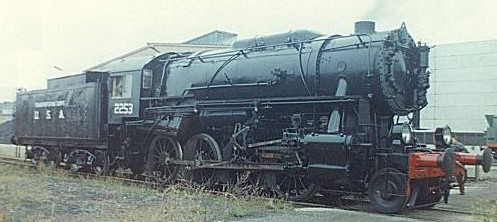 Tr203
Tr203
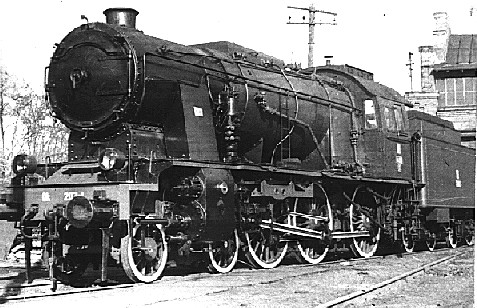 This photo shows the result – the
Pila built prototype of a new steam locomotive called Ok55-1.
This photo shows the result – the
Pila built prototype of a new steam locomotive called Ok55-1.
The American boiler was a modern one, all welded and with circulation tubes. The ends of them are being seen on this photo from the inside of the driver’s cabin.
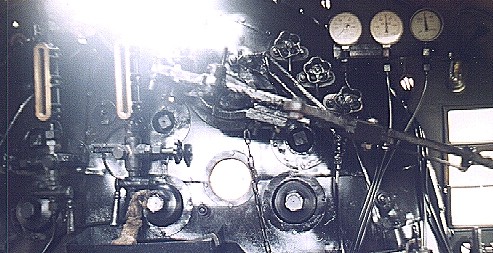
When the new locomotive was positively approved, the results of the test rides led to a 100 % new construction of that locomotive called Ok55-3.
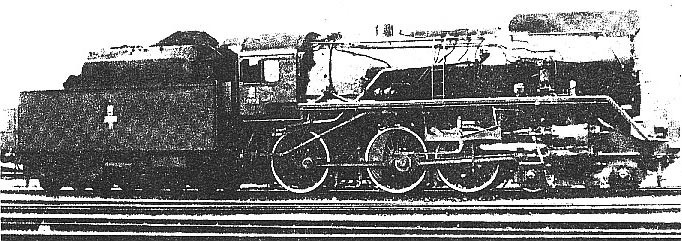
The boiler was almost the same as before, but there was a pre-heater installed in front of the smoke box in order to enlarge the heating surface. By doing so, the locomotive gained more power without changing the main parameters.
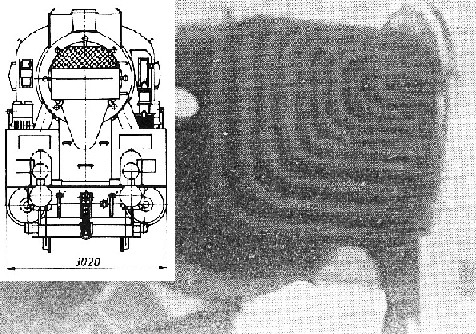
The frame was manufactured out of thicker metal
plates, and stiffened with a special ribs structure, so that it
was possible to install roller bearings of own design and
production. For all axles, and the rods. 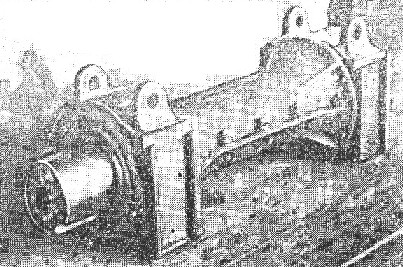
Again, the economic efforts were encouraging – the locomotive with roller bearings showed up to 25 % less air resistance than the prototype without roller bearings.
III CONCLUSION:
A STEAM LOCOMOTIVE OF THE FUTURE OUGHT TO USE ROLLER BEARINGS, plus incorporate as many as possible modernisations such as GPCS system in order to give the best economic, and ecological effects.
AN OUTLOOK ONTO THE FUTURE:
A STEAM LOCOMOTIVE OF THE FUTURE OUGHT TO COMBINE THE NAMED ABOVE BENEFITS WITH THE COMBUSTION OF RENEWABLE ENERGY.
We are planning to modify a German 50 or 52 class steam locomotive for the JURA (French association CFTPV) to TIMBER GAZIFICATION (shredded wood or pellets). This is one of the projects INTERLOK discussed with the late L.D.PORTA that still waits for it’s realization.
1. The usage of renewable energy, and hopefully roller bearings, is important in touristic areas where the gaining of drinking water from the grounds does not allow to use diesel locomotives. It is a step to support ecological goals of the World Community. ALSO INTERESTING: The usage of renewable energy means the owner might in the future sell certificates (according to the KYOTO agreement) to companies that are not yet taking part in ecological projects.
2. Tourists like steam locomotives. But it is more and more difficult to get good quality steam locomotive coal in Europe! Germany does not produce it. Polish coal is too expensive in Poland itself, and is usually not delivered in small museum railway quantities abroad. Coal coming from Australia or other far away destinations does not always fulfil the requirements of steam locomotive firing. The usage of renewable energy (timber) is therefore a real alternative for steam locomotives.
3. GPCS-system gives a more more complete transformation of the fuel >>> less remindings to be dumped.
4. GPCS-system ensures a combustion with much less pollution >>> no problems with modern ecologic standards.
Further experiments have to include:
a) shredded wood or timber pallets? To run a train the same distance as with coal, we need a tender volume 7 times larger than for coal, but only 2 times larger than for coal provided we use pellets. Depending on local circumstances, one might also use for example bagasse (an end product of sugar cane production), or other similar renewable sources. The firing system (Stoker or other system) has to be adapted and improved.
b) An improved draught. The late L.D.Porta intended to improve his LEMPOR exhaust draught by a LEMPREX draught.